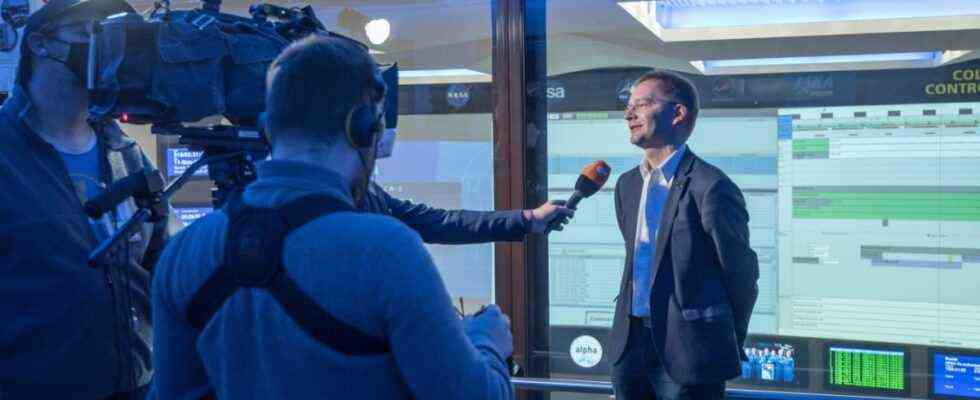The night sky over Oberpfaffenhofen is clear as stars and the air is cold, the temperatures are just below freezing point. The premises of the German Aerospace Society (DLR) are almost deserted at this time in the middle of Thursday night. Only in the control center has a group gathered to watch a rocket launch in the Kennedy Space Center in Florida. There, a good 7,800 kilometers away in the west, Matthias Maurer from Saarland and three other astronauts make their way to his new workplace on the international space station ISS. And in Oberpfaffenhofen, technicians and scientists ensure that it has enough electricity, that it doesn’t get too warm up there and that the air doesn’t get too humid. You keep the Columbus module running and make sure that everything works.
“We are working ahead of the astronauts. We are clearing the way so that they can work there as effectively as possible.” This is how the flight controller Florian Bender describes the tasks that he and a good 30 colleagues take on in the DLR team. He was one of the few scientists who watched the rocket launch shortly after 3 a.m. on a giant screen in the control room. “It’s always exciting,” he says. The flight, which lasted a total of 22 hours, ran smoothly and according to plan until Thursday evening. During the night the Dragon space capsule was supposed to dock with the space station.
Felix Huber, Director of the German Space Control Center in Oberpfaffenhofen, explains details of the “Cosmic Kiss” mission.
(Photo: Arlet Ulfers)
A large screen in the control center in Oberpfaffenhofen shows what the astronauts are doing on the ISS: experiments, sports, sleeping. “At the moment they are all asleep,” says Felix Huber, Director of the German Space Control Center (GSOC), while watching the rocket launch on a screen. And that will also be Maurer’s first task for the next six months after arriving at his new home 400 kilometers above the ground: lying down and sleeping. After the rest phase, the 51-year-old should first familiarize himself with the station. “After all, it has the internal volume of a Boeing 747 and is pretty nooks and crannies,” explains DLR engineer Bender, who takes on planning and coordination tasks from the ground. Safety training is also part of the familiarization phase in space, knowing where escape routes are and where a fire extinguisher can be found.
As part of his “Cosmic Kiss” mission, Maurer is carrying out 36 German and more than 100 international experiments on board the ISS. The German Space Control Center in Oberpfaffenhofen is responsible for planning and carrying out the experiments in the European Columbus module. These tests are supervised from various locations across Europe, in Cologne, Belgium, Toulouse, Switzerland and Spain. “And with us, the threads come together,” says Bender.
Finally lifted off: The rocket launch in Cape Canaveral, which has been postponed several times, is shown on a screen at DLR Oberpfaffenhofen.
(Photo: Arlet Ulfers)
A few examples: For example, radiation exposure is measured outside the Columbus laboratory and a bio-printer is tried out for wound care. Human respiratory gases such as oxygen and carbon dioxide as well as heartbeat and body temperature are measured to improve astronauts’ training. And a few student projects are also on the to-do list. Maurer took rocket and radish seeds with him into space, which are supposed to germinate on a soil similar to that found on Mars, according to a brief description from DLR. As part of a primary school competition, children from third and fourth grades will then become researchers and find out how the “Space Seeds” survived the journey.
The ESA astronaut Maurer is expected to leave the ISS again in April and return to Earth in a space capsule. For the scientists and technicians in Oberpfaffenhofen, however, the work continues. You will continue to regulate the power supply in the Columbus module from the control center, switch the water pumps on and off and again watch the start of the next mission with excitement.

